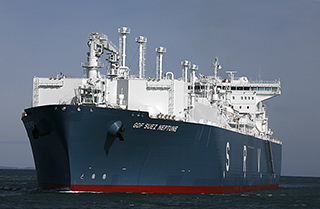In a major setback to the industry, New York Gov. Andrew Cuomo vetoed plans for the offshore Port Ambrose liquefied natural gas terminal, asserting that the project would pose unacceptable risks to other parts of the maritime economy, tourism and security.
Cuomo exercised his prerogative to reject the project under federal rules, one week into a 45-day review period by the U.S. Maritime Administration. That would effectively kill the proposal, which had been supported by business and labor groups in the New York Harbor region, but fiercely opposed by environmental groups and their allies in fishing and seaside tourism.
The would-be developers Liberty Natural Gas, Short Hills, N.J. touted the project as offering New York and New Jersey consumers relief from natural gas price spikes during the winter heating season, without the perceived risk of LNG tankers coming into the port itself.
In a statement after Cuomo’s office announced the decision Nov. 12, Liberty Natural Gas CEO Roger Whelan said the company was surprised by the move.
“We had hoped the safety and environmental concerns raised by the Governor this afternoon had been thoroughly addressed by the environmental impact statement,’’ Whelan said.
At a site at the apex of the New York Bight almost 19 miles south of Fire Island, N.Y. and almost 28 miles west of the harbor’s south entrance at Sandy Hook, N.J., the terminal would consist of submerged turret risers with connections to the existing Transco Lower New York Bay Lateral, a sub-seabed natural gas line between New Jersey and New York.
entrance at Sandy Hook, N.J., the terminal would consist of submerged turret risers with connections to the existing Transco Lower New York Bay Lateral, a sub-seabed natural gas line between New Jersey and New York.
Liberty would import gas from Trinidad and Tobago in shuttle and regasification vessels (RSVs), LNG tankers with the capability to dock with turret connections, and discharge warmed gas at the terminal for distribution to the regional grid.
Liberty would partner with Norway-based APL for the turret riser and terminal design, and with Hoëgh LNG, another Norwegian company that builds and operates RSVs. Each delivery could put an average 400 million cubic feet of gas into the regional grid, enough for 1.5 million homes, the company said.
Environmental, recreational and fishing groups generally opposed the project, as they have other offshore industrial and energy projects in the region. They brought local governments from shore communities into the fray, while Liberty worked to get the endorsement of business and labor.
“We trust now that the Maritime Administration will quickly reject this project, as required by law. This is a hard won seven year battle,” said Cynthia Zipf of the New Jersey-based Clean Ocean Action, one of the groups that coordinated opposition.
Zipf and other activists pressured New Jersey Gov. Chris Christie to take the same action as Cuomo – as Christie did in 2011, when he vetoed a similar proposal from Liberty for offshore of Asbury Park, N.J.
In the throes of his national campaign for the Republican presidential nomination, Christie was mum on the Port Ambrose plan, although his spokesmen stood by Christie’s earlier positions that an offshore terminal was not in the state’s interest.





